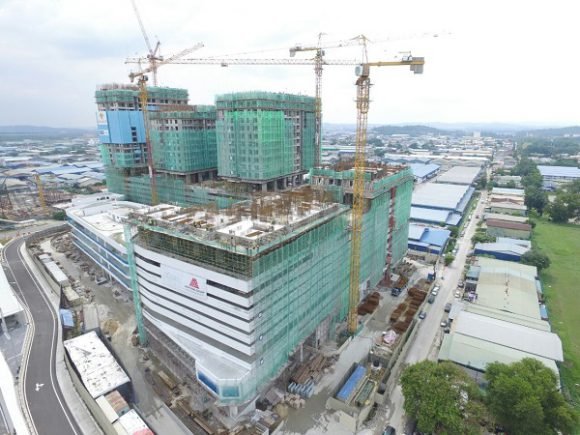Khairy: Youths most concerned about education, affordable housing, transportation, jobs
Affordable housing, transportation and job opportunities remain of the greatest concern to youths, judging from the topics most discussed during the National Transformation 2050 (TN50) dialogues. Youth and Sports Minister Khairy Jamaluddin said, other than equal education for all, these were the topics raised in every one of the dialogue sessions. He said technological change was inevitable and the country needed to find ways to educate and prepare the children holistically to face these challenges. The TN50 discourse series is aimed at gathering the views and hopes of the people, particularly the youth, to generate a new, 30-year transformation plan for the country that truly reflects the people’s vision. (NST Online)
Govt’s affordable houses may pose future threat to private developers
The government’s affordable housing schemes for Malaysians could in the future be a threat to private developers who will not be able to match the lower subsidised prices, Rehda Institute has said. Private developers had in the past decade up until 2014 mostly built high-end and larger condominium units, but had only adjusted in the past few years to rolling out projects that were more affordable. This had resulted in a gap between demand and supply of such homes for Malaysians. It is not a threat today because the gaps are being filled to meet demand. However, when the gap between demand and supply starts to narrow as the private sector builds more affordable housing, it would result in competition between the private sector and the public sector. (Malay Mail Online)
Construction of D’Sara Sentral ahead of schedule
Construction of Mah Sing Group Bhd’s mixed development in Sungai Buloh — D’sara Sentral — is now between 12 months and 15 months ahead of schedule, with four of six building components to be completed and targeted for vacant possession by as early as the second quarter of 2018. D’sara Sentral comprises five residential towers, namely the SoVo Tower, SA1 and SA2 Towers, SB1 Tower and OLO Residence Tower. The project also has a four-storey retail shopping area. The entire development is targeted for completion by the first quarter of 2019. Launched in 2014, it has a GDV of RM937 million and currently has an over 80% take-up rate. (The Edge Markets)

D’Sara Sentral is targeted for completion by 1Q 2019 (Photo from Mah Sing Group)
Zecon to develop RM11bil project in Kuching
Zecon Bhd plans to undertake a mixed property development project in Kota Petra, Kuching, Sarawak, with a total GDV of RM11 billion. The 1,203ha Kota Petra project would be the group’s largest property development, comprising multiple clusters, including proposed state and federal new administrative centres, tourism enclave, education city, resort destination, integrated affordable homes and a medical city. There will be 1,065 PR1MA residential units and 2,332 PPA1M units within the development. (The Star Online)
SP Setia 3Q profit jumps 88.9%
SP Setia announced its net profit for 3QFY17 had surged 88.9% year-on-year to RM253.22 million, driven by contribution from its UK Battersea Power Station project. Quarterly revenue came in lower at RM842.49 million versus RM1.26 billion last year, on lesser overall recognition from its Malaysian operations as projects were completed and handed over in the previous quarter. The group has several phases of large developments that are still at the early stages of construction, including phase one of Setia Eco Templer in Rawang, ViiA Residences at KL Eco City, and Setia EcoHill 2 in Semenyih. (The Edge Markets)
Naim Indah scraps Gateway Klang management project
Property developer Naim Indah Corporation has agreed to scrap a management consultancy deal for the Gateway Klang project. Project owner Lagenda Erajuta, a privately-held firm controlled by two Naim Indah directors, agreed to end the deal due to the delay in getting approval for land transfer and change in land usage status from authorities. The deal was part of Naim Indah’s diversification plan into project management business that could add at least 25% to future net profit when it was announced in February 2015. (Nikkei Asian Review)
 Battersea Power Station tunneling work in London completed
Battersea Power Station tunneling work in London completed
The two 3.2 km tunnels from Battersea Power Station, via Nine Elms, have been built as huge tunnel boring machine broke through at Kennington, the first major extension to London’s Tube line since the Jubilee line in the late 1990s. The extension of the line was targeted for completion in 2020. Battersea Power Station is one of central London’s largest, most visionary and eagerly anticipated new town centres in which roughly half the development would comprise of shops, restaurants and office space. (Malay Mail Online)
 Singapore property market rebounding
Singapore property market rebounding
Since June last year, there has been a change in developers’ and consumers’ appetite for private properties in Singapore. Billion-dollar bids for government land, larger and larger quantum paid for private projects for redevelopment and new launches of condominiums sold out in a day have been headlines for Singapore’s private residential property market. One of the reasons for the surge in the number of billion-dollar land bids is the sites offered for sale by the government are located at the relatively good locations. Another reason would be the depleting landbank that caused developers to bid aggressively, especially the foreign developers. Other factors to note were high vacancy rates and unsold inventory compared to historical levels. Investors are urged to consider these aspects to avoid over-paying for sites or homes. (NST Online)
Malaysia’s labour force reaches 15 million
The labour force in Malaysia has reached 15 million from the country’s population of 32 million, according to the Department of Statistics. The total of women’s workforce had increased to 5.76 million in the third quarter from 5.72 million in the second quarter, while the unemployment rate remained at 3.4%. According to the statistics, seven million or 32% of the people within working age were not in the workforce as they were either still studying, working from home, had taken early retirement, disabled or simply not interested to work. (NST Online)





